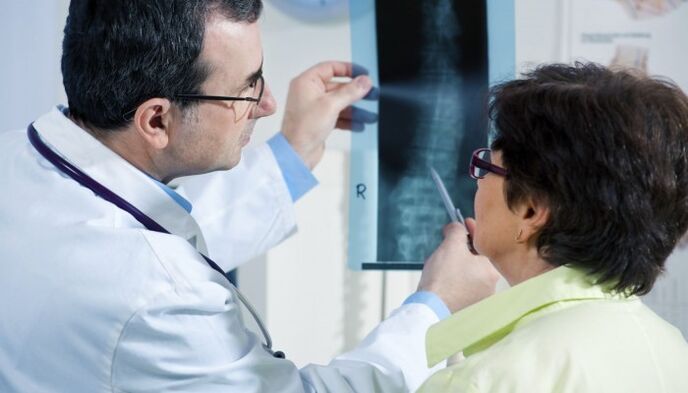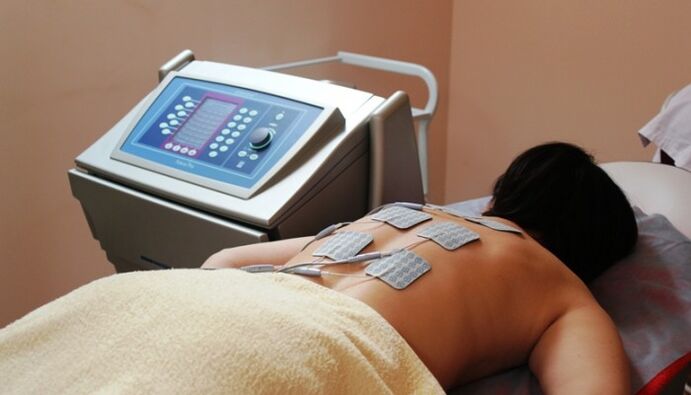Osteochondrosis is a chronic pathology of the spine, the main cause of which are degenerative changes in the intervertebral disc. With the progression of the disease, other structures of the spine are also involved in the pathological process - vertebral bodies, intervertebral joints, ligaments, etc.
The disease affects people of all ages. Until recently, osteochondrosis was considered the fate of older people, but recently an increase in the incidence of this disease in young people has been noted. Both women and men are equally affected.
Why does osteochondrosis occur?
In order to better understand what osteochondrosis is, it is necessary to briefly consider the causes and mechanism of its occurrence.
The formation of pathological changes in osteochondrosis of the spine occurs slowly. From the beginning of the pathological process in the intervertebral cartilage to the manifestation of the first symptoms of osteochondrosis, years often pass.
Causes of osteochondrosis
Spinal health is directly influenced by many negative factors. If their influence is exerted for a long time, this leads to the appearance of pathological changes in the structures of the spine. And this contributes to the development of osteochondrosis.
For example, what is osteochondrosis is well known to people who lead an inactive lifestyle, who are overweight. Excessive physical activity, back and neck injuries, some somatic diseases can also lead to the development of this pathology. And complicated heredity and age are direct factors that lead to the development of degenerative damage to the cartilage tissue of the intervertebral discs.
How does osteochondrosis develop?
The mechanism of development (or pathogenesis) of osteochondrosis is still controversial and insufficiently studied. It is very likely that this disease arises on the basis of metabolic disorders that occur in the structures of the spine.
Under the influence of unfavorable factors, irreversible changes in the cartilage tissue of the intervertebral disc often occur, followed by their gradual destruction (or destruction).
Then the pathological process also spreads to the bone tissue of the vertebra with the development of its deformation and irreversible changes in the surrounding structures.
The occurrence of such modifications in the intervertebral disc directly depends on its anatomical nuances:
- Cartilage tissue does not have its own blood supply system. Its nutrition is provided by the bone tissue of adjacent vertebrae. In the case of circulatory disorders as a result of insufficient or, conversely, excessive physical stress on the spine, cartilage nutrition also suffers.
- There are also no nerve fibers in the cartilage. Consequently, when the intervertebral disc is functionally overloaded, the transmission of a nerve impulse that triggers the activation of the metabolism occurs prematurely.
- The ability of the cartilage tissue of the intervertebral disc to self-heal (regenerate) is slowed down due to its structural peculiarities.
There are also other factors that clearly contribute to the development of degenerative processes in the cartilage tissue of the intervertebral discs and the development of osteochondrosis.
Stages of pathological changes
Based on current data on the pathogenesis of this pathology, several stages of the degenerative process in the intervertebral disc can be conditionally distinguished. Stages of osteochondrosis of the spine:
- Elementary. The cartilage tissue of the intervertebral disc undergoes structural changes under mechanical influences - functional disorders occur. Characterized by the appearance of cracks on the surface of the disc, differing in size and depth. Subsequently, these tears are transformed into protrusions (hernias).
- medium. It is characterized by the appearance of instability of the affected area of \u200b\u200bthe spine due to pathological mobility of the vertebrae. In this case, one of the main functions of the spine, the protective function, is disrupted. Nerve and vascular trunks running in its bone canals become vulnerable. Vivid clinical symptoms of the disease develop.
- Finally. The affected cartilage tissue is replaced by coarser and denser fibrous tissue. At the same time, intervertebral hernias disappear. And the pathological mobility of the vertebrae is replaced by a sharp limitation of their mobility. Often there is a narrowing of the spinal canal with the development of manifestations of compression of the segments of the spinal cord.
Therefore, each stage of the disease is characterized by the presence of its own specific symptoms, which undoubtedly plays a key role in the choice of methods of treating osteochondrosis.
Clinical Manifestations
Signs of spinal osteochondrosis appear as changes in the bone tissue of the vertebrae. The patient may not have any discomfort for a long time.
The disease is characterized by a chronic course, with alternating phases of exacerbation and remission.
Often an exacerbation of osteochondrosis occurs under the influence of provoking factors: physical overexertion, hypothermia, prolonged exposure to an uncomfortable position, for example, in a dream or at work, etc.
There are many symptoms of this disease, depending on the localization of the pathological process and the severity of structural changes in cartilage and bone tissue. All of these symptoms can be classified into several syndromes. They are often combined.
radicular syndrome
It occurs in almost all patients with osteochondrosis of the spine. Compression (compression) of the roots of the spinal nerves by pathologically altered structures of the spine plays a role in the occurrence of this syndrome.
The main sign of radicular syndrome is pain, which in a significant number of cases can spread along the course of innervation of the corresponding root (radiation). Characterized by radiating pain from top to bottom. For example, if the lumbar region is affected, the buttocks hurt and the leg gives way.
Pain intensity increases with trunk or neck rotation and physical activity. Pain sensations are characterized as cutting, pulling, baking.
Along with the pain syndrome, symptoms of a violation of sensitivity by the nature of its increase (hyperesthesia), as well as impaired sensitivity, numbness, often develop in the affected area.
As the disease progresses and the cause of the compression is not eliminated, hyperesthesia is replaced by hypesthesia (reduction in sensitivity), which is often accompanied by symptoms of loss of function of the affected spinal root.
spinal syndrome
This syndrome develops as a result of compression of the spinal cord. The most common cause of such compression is an intervertebral hernia.
Sensitivity, reactions to temperature and pain stimuli decrease progressively. Progressive muscle weakness develops in both the limbs and trunk. Paretic or paralytic symptoms are often formed.
Vegetative-vascular syndrome

This syndrome most often develops in the cervical and cervicothoracic localization of spinal osteochondrosis.
The cause of vascular diseases in osteochondrosis is a reflex spasm or mechanical compression of large vessels passing in the bone canals of the spine. Various symptoms can develop that resemble an ischemic circulatory disorder of the brain or the main arteries of the extremities. This is often the cause of diagnostic errors.
In addition, various vegetative disorders often develop. They are most pronounced in women (emotional lability, sleep disorders, menstrual irregularities, etc. ).
visceral syndrome
It is characterized by the appearance of pain in the projection of the heart, organs of the gastrointestinal tract, etc. Often such patients are treated for somatic diseases for a long time and absolutely unsuccessfully.
For example, if the thoracic region is affected, pain behind the breastbone can occur, which is similar to that of angina pectoris. Often there is a reflex sensation of the heartbeat.
Diagnostic Principles
In addition to the characteristic symptoms, other examination methods play an important role in the diagnosis and staging of the disease - X-ray of the spine, computer and magnetic nuclear tomography.
Depending on the indication, other methods are carried out, e. g. B. EEG, ECG, Doppler scanning of blood vessels, etc.
Treatment of osteochondrosis

Therapy of osteochondrosis of the spine is a holistic approach. When choosing one or another method of treatment, it is necessary to assess the degree of damage to the structures of the spine, the nature and severity of clinical manifestations, as well as the stage of the course of the disease (exacerbation or remission). .
An important role in the treatment of spinal osteochondrosis is also played by preventive measures aimed at reducing the frequency of exacerbations of the disease and preserving the structure of the vertebrae and intervertebral discs.
Tactics during an exacerbation
An important condition for the treatment of the disease during this period is the creation of rest in the affected area of \u200b\u200bthe spine. For this, the patient is prescribed bed rest using various tools to immobilize the affected vertebral segment.
In some cases, hospitalization in the neurology department is required.
Medical treatment
To reduce the intensity of pain in osteochondrosis, various drugs are prescribed:
- nonsteroidal anti-inflammatory drugs (NSAIDs);
- Analgesic;
- muscle relaxants.
In the absence of the effect of their use, it is advisable to prescribe blockades of the innervation of the affected area using local anesthetics.
With cervical localization of osteochondrosis, circulatory disorders of the brain often develop. To reduce such manifestations, drugs that improve cerebral blood flow are prescribed. It is also necessary to use symptomatic means - relieving nausea and vomiting, improving balance disorders, etc.
In addition, it is advisable to prescribe vitamin preparations (especially group B), antioxidants and some others.
Physiotherapeutic procedures

In osteochondrosis, treatment with physical factors has found wide application. Various methods of physiotherapy are used both during the exacerbation and in the remission phase of the disease:
- In the acute period, UV irradiation, treatment with electromagnetic fields (UHF), diadynamic current, etc. are used.
- In the period of remission, electrophoresis with various drugs, inductothermy, ultrasound and various types of balneotherapy are prescribed.
Tactics in the remission phase
After the acute manifestations of the disease subside, treatment of the disease continues. The purpose of such therapy is to reduce the frequency of exacerbations and promote the regeneration of bone and cartilage tissue of the spine.
Drug treatment prescribed for the acute phase of the disease continues. During this period, chondroprotectors can be used - means that improve the condition of the cartilage.
In addition to physiotherapeutic methods, massages and physiotherapeutic exercises are also used.
massage

The main effect of the massage is aimed at improving blood circulation in the affected area and strengthening the muscular corset. Also, professionally performing massage movements, you can relieve muscle spasms that usually accompany this pathology.
Therefore, the massage should be carried out by a specially trained specialist who is fluent in this treatment method. Incorrectly or illiterately performed massage can lead to the development of complications or an exacerbation of the disease.
Remedial gymnastics (LFK)
Dosed and specially selected physical exercises form the basis of movement therapy. The complex of such exercises is selected by the doctor individually for each patient. The principle of choosing exercise therapy exercises is to reduce the physical load on the affected area of \u200b\u200bthe spine.
The effect of physiotherapeutic exercises is aimed at improving blood supply and lymphatic flow to the affected area, strengthening muscle tissue.
These exercises should be done every day. As a rule, first individual or group classes are held with an instructor, then the patient can independently perform a set of exercises at home.
Prevention of exacerbations
Preventive measures to aggravate spinal osteochondrosis are aimed at eliminating all provoking factors:
- It is necessary to monitor the correct posture and posture during long periods of standing and sitting.
- For sustained static loads (e. g. computer work), it makes sense to take regular breaks during which you should warm up or complete an exercise series recommended by your doctor.
- Hypothermia should be avoided.
- It is important to sleep properly with osteochondrosis, take care of a place to sleep - a mattress and a pillow. Ideally, they should be orthopedic.
- Obligatory is the reduction of excess weight and the timely correction of the concomitant somatic and endocrine pathology.
And if the slightest symptoms of a spinal disease appear, you should not hesitate to consult a doctor. After all, the earlier the treatment of osteochondrosis of the spine is started, the better the results.















































